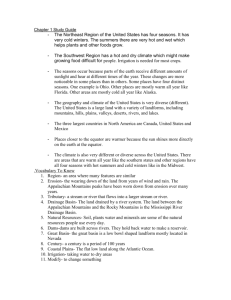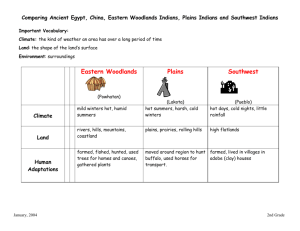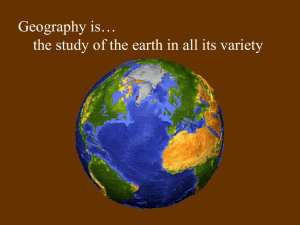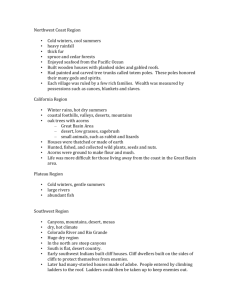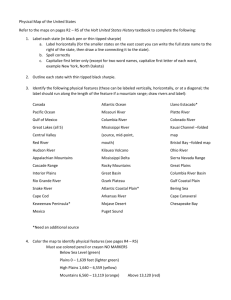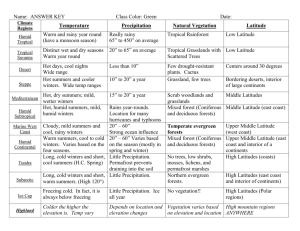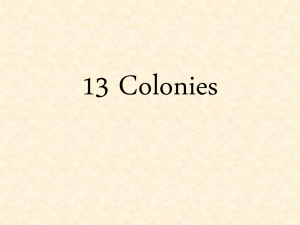Chapter 1 Notes
advertisement
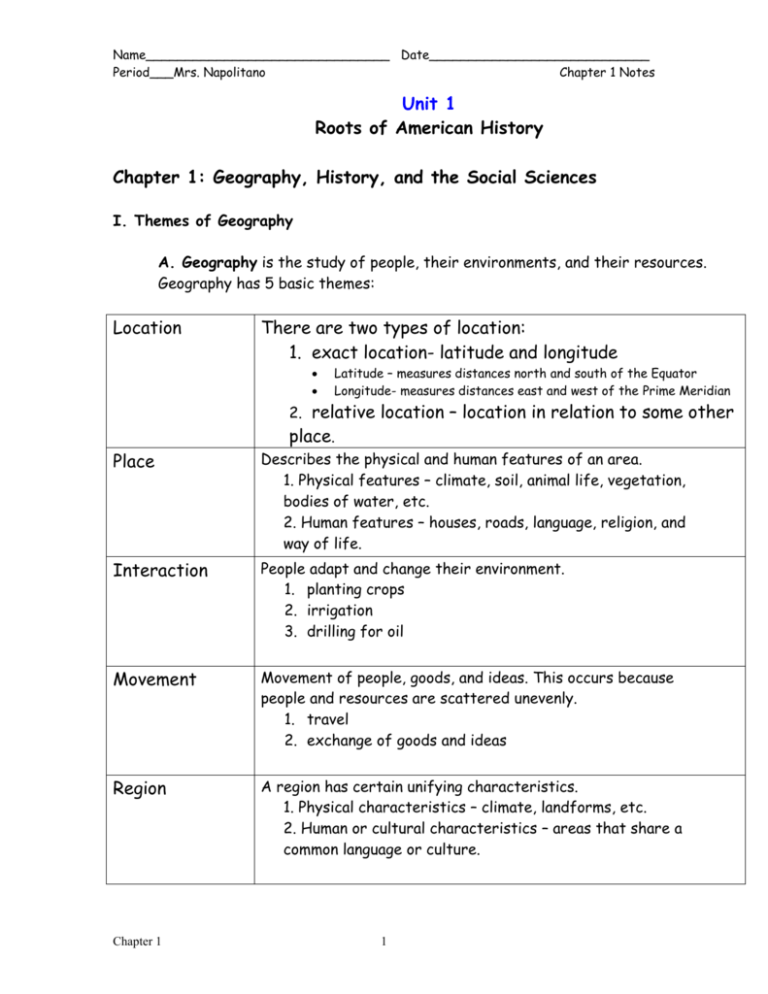
Name_______________________________ Date____________________________ Period___Mrs. Napolitano Chapter 1 Notes Unit 1 Roots of American History Chapter 1: Geography, History, and the Social Sciences I. Themes of Geography A. Geography is the study of people, their environments, and their resources. Geography has 5 basic themes: Location There are two types of location: 1. exact location- latitude and longitude Latitude – measures distances north and south of the Equator Longitude- measures distances east and west of the Prime Meridian 2. relative location – location in relation to some other place. Place Describes the physical and human features of an area. 1. Physical features – climate, soil, animal life, vegetation, bodies of water, etc. 2. Human features – houses, roads, language, religion, and way of life. Interaction People adapt and change their environment. 1. planting crops 2. irrigation 3. drilling for oil Movement Movement of people, goods, and ideas. This occurs because people and resources are scattered unevenly. 1. travel 2. exchange of goods and ideas Region A region has certain unifying characteristics. 1. Physical characteristics – climate, landforms, etc. 2. Human or cultural characteristics – areas that share a common language or culture. Chapter 1 1 II. Thinking Geographically A. Tools of Geographers 1. Globes – Shaped liked the Earth, a globe gives a true picture of the size and shape of landmasses and of distances across oceans. 2. Map Projections- ways of showing the curved Earth on a flat surface. Mapmakers, or cartographers have developed dozens of map projections. a) Mercator projection- shows the true shapes of landmasses, but distorts its size, especially for places that are far from the Equator. b) Robinson projection- shows correct sizes and shapes of landmasses for most parts of the world. Many geographers use this type of map today. 3. Special-Purpose Maps (Thematic Maps) a) Political map- shows political boundaries. b) Physical map (Topographic map)- shows natural features, such as mountains and lakes. c) Population map- lets you see how many people live in the various urban and rural areas. d) Natural Resources map- shows the resources of an area. e) Economic map- shows how people make a living in a given area. B. Making Accurate Maps 1. Landsat maps- Landsat 1, the first satellite specially designed to study the Earth’s surface from space, was launched in 1972. a) The satellite made a complete circle of the Earth every 103 minutes, 14 times a day. b) Within two years, Landsat had photographed more than 80% of the Earth’s land areas at least once. Name_______________________________ Date____________________________ Period___Mrs. Napolitano Chapter 1 Notes C. Latitude and Longitude 1. Latitude - measures distances north and south of the Equator. a) Equator - imaginary line that lies at zero degrees latitude. It divides the Earth into two hemispheres (northern & southern). 2. Longitude - measures distances east or west of the Prime Meridian. a) Prime Meridian - imaginary line that lies at zero degrees longitude. It divides the Earth into two hemispheres (eastern & western). D. Time Zones 1. Standard Time Zone- the world is divided into 24 time zones. a) Standard time is measured from the Prime Meridian, which runs through Greenwich, England. b) If you travel half way around the world from the Prime Meridian you reach the International Date Line, which falls at 180° in the Pacific Ocean. Chapter 1 3 III. The American Land A. Types of Landforms 1. Mountains- are at least 1,000 feet above the surrounding land. a) Elevation – height above sea level. b) Relief – is the difference in height of land. 2. Hills- are lower and less steep than mountains. 3. Plains- large areas of fairly gentle or rolling land. 4. Plateaus- large areas of high flat gently rolling land. B. North America from West to East- The mountains, hills, plateaus, and plains of North America form nine major physical regions. 1. Pacific Coast- In the West, it includes tall mountain ranges that stretch from Alaska to Mexico. 2. Intermountain Region- East of the Pacific Coast, it is a rugged region of Mountain peaks, plateaus, deep canyons and deserts. 3. Rocky Mountains- Include some of the highest peaks in North America. 4. Interior Plains- A large lowland area between the Rocky Mountains and the Appalachians. It is divided into two areas. a)The Great Plains – the dry western area. c) The Central Plains – the eastern area. 5. Ozark Highlands- extends across southern Missouri and northern Arkansas and into eastern Kansas. Includes thick forests and mountains that rise to about 2,000 feet. 6. Appalachian Mountains- run along the eastern part of North America. 7. Canadian Shield- a lowland area (near Lake Superior), most of which lies in eastern Canada. 8. Coastal Plains- a lowland area on the east coast, it is divided into the Atlantic Plain and the Gulf Plain. 9. Hawaiian Islands – The islands are tops of volcanoes that erupted in the Pacific Ocean. Name_______________________________ Date____________________________ Period___Mrs. Napolitano Chapter 1 Notes C. Rivers and Lakes - Great river systems crisscross North America. 1. The Mississippi and Missouri rivers make up the largest river system in the United States. a) Tributaries- are streams and small rivers that flow into larger rivers. 2. The Great Lakes – consists of 5 large lakes that form part of the border between the United States and Canada (the largest body of fresh water in the world). a) Lake Superior d) Lake Erie b) Lake Michigan e) Lake Ontario c) Lake Huron Chapter 1 5 IV. Climates of the Americas A. Factors that Effect Climate 1. Weather is the condition of the Earth’s atmosphere at any given time and place. 2. Climate is the average weather of a place over a period of 20 or 30 years. The 2 main aspects of climate are a) temperature b) precipitation – rain, snow, hail, or sleet. 3. Two important factors that determine climate are: a) Location b) Altitude or height of the land above sea level. d) Ocean currents, wind currents, and landforms also influence climate. B. North American Climates - The United States has 10 major climates that strongly influence the nation’s population patterns and economic activities. 1. Marine- warm summers and cool winters. a) from southern Alaska to northern California 2. Mediterranean- Winters are mild and wet. Summers are hot and dry. a) most of California. 3. Highland- generally cooler temps. Seasons and rainfall vary with elevation. a) The Cascades, Sierra Nevada, and Rocky Mountains. 4. Steppe- Limited rainfall. Summers are hot, winters are cold. a) The Great Plains. 5. Desert- almost no rainfall, with hot days and cold nights. a) Nevada, Arizona, and eastern California. 6. Humid Continental- mild summers and cold winters. It has more precipitation than the Steppe. a) The Central Plains and the northeastern United States. 7. Humid Subtropical- Warm weather and regular rainfall. a) The southeastern U.S. 8. Tropical- Hot and humid. a) Southern Florida and Hawaii. 9. Tundra (Artic) - It is cold all year round. a) Northern and western Alaska 10. Subarctic- Very short summers and long cold winters. a) The rest of Alaska and northern Canada. Name_______________________________ Date____________________________ Period___Mrs. Napolitano Chapter 1 Notes V. The Tools of History A. Using Historical Evidence 1. Primary Source- firsthand information about people or events. a) Some examples include official documents, public speeches, and eyewitness accounts such as diaries, letters, and autobiographies. b) Authenticity – refers to whether or not the source is actually what it seems to be. c) Reliability – refers to whether or not the source gives an accurate account of the events being described. Historians must be on the lookout for bias. d) Bias – a leaning toward or against a certain person group or idea. 2. Secondary Source – an account provided after the fact by people who did not witness the event, but are usually based on primary sources. a) Some examples are textbooks, encyclopedias, and biographies. 3. Interpreting Evidence – By explaining why things happened in the past, historians can help us understand the present, and what may happen in the future. a) Sometimes that same primary source may be interpreted differently as a result the historians own bias. b) Interpretations may change over time, influenced by current events, new ideas, and new sources. 4. Archaeology is the study of evidence left by early peoples in order to find out about their way of life. a) Artifacts- objects made by humans and used by archaeologists to recreate a picture of the past. b) Archaeologists form theories about cultures. c) Culture- the entire way of life that a people have developed. 5. Chronology and Historical Eras a) Learn from the past and see how it is linked to the present. b) Learn about how people lived and shaped our country. c) Absolute chronology answers the question when an event took place. d) Relative chronology helps in understanding connections between different events Chapter 1 7 VI. Economics and Other Social Sciences A. Three Economic Questions – The study of how people manage their limited resources to satisfy their wants and needs is called economics. 1. What goods and services should we produce? a) First you must fulfill people’s basic needs – food, shelter, and clothing. b) After that society must make choices about how to use the rest of its limited resources (ex. Cars, washing machines, education?). c) Decisions about what to produce vary according to time and culture. 2. How should we produce goods and services? a) Technology plays a major role in these decisions. 3. For whom should we produce goods and services? – We are all consumers, or users of goods and services. a) Resources and supplies of goods and services are limited. b) In the past consumers produced the goods they consumed themselves. c) Today, we live in a cash economy, an economy where we exchange money for goods and services. B. The American Free Enterprise System 1. In a free enterprise system, the government plays a limited role in the economy. a) Business owners decide what products to make, how much to make, where to sell their products, and what prices to charge. b) Competition gives business an incentive, or reason for working harder, trying to make the best product at the lowest price. c) Allows consumers freedom to make economic choices. Name_______________________________ Date____________________________ Period___Mrs. Napolitano Chapter 1 Notes C. Other Social Sciences – Economics, history, and geography are considered social sciences because they relate to human society and social behavior. Other social sciences include: 1. Political Science –The study of government. a) Political scientists look at the ideas behind different forms of government, how they are organized, and how they work. b) Civics- the study of the rights and responsibilities of citizens. 2. Anthropology- the study of how people and cultures develop. a) Anthropologists look at the ways people thought and behaved at different times and places. 3. Sociology-is the study of how people behave in groups. Sociologists look at: a) social structures (classes). b) how families are organized c) the roles of men and women and how they differ. d) the values and beliefs people share. 4. Psychology- is the study of how people think and behave. a) Psychology can help us understand why people act in a certain way. Chapter 1 9
